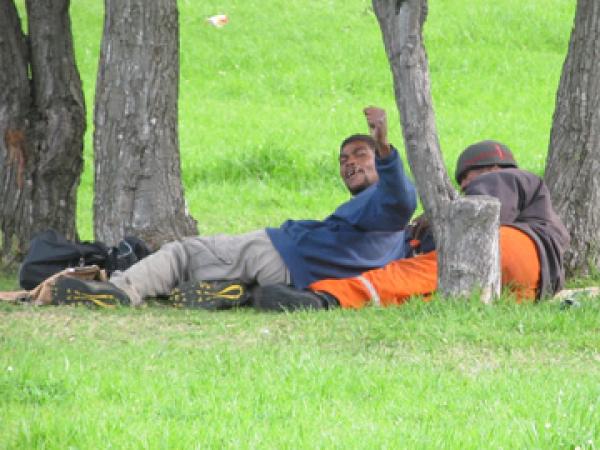Where Cape Town’s homeless live

Nestled underneath a concrete highway, the District Six Haven shelter is a modest, two-storey house where 80 of the area’s homeless live.
Nestled underneath a concrete highway, the District Six Haven shelter is a modest, two-story house where 80 of the area’s homeless live. When GroundUp visited the shelter was crowded with Nelson Mandela Day volunteers unloading crates of fresh food in the yard, while the shelter’s residents were bustling about helping and doing their daily chores.
Sheila Jacobs, the local manager of the shelter, explains that the shelter provides three home cooked meals and basic accommodations for just R10 a night, which the residents usually earn through casual work during the day. There’s no pressure, however—residents are allowed to stay regardless of whether they come up with the money, and many work for the shelter itself.
“We also provide skills training, and if we can, we try to contact the families,” she added. “Our aim is to get the homeless to a home.”
The homeless in the area, according to her, have wound up on the streets for a variety of different reasons. While many suffer from drug and alcohol addictions, each person is unique and should not be categorized. Sheila explains that most of the clients are black males, but there are also white and colored residents as well.
Anslem, one of the residents of the shelter, described his own descent to homelessness as a result of drug use and tik, but said that many others were there simply because they couldn’t find employment. “You’ll find electricians, builders and all types of skilled workers,” he said. However, he does admit that that drug use is a problem, especially in youngsters, and should be better addressed by the government.
Ron, another resident, came from Johannesburg to find a new life, but found himself instead succumbing to homelessness. He praised the shelter, however, for “helping me make something out of myself. I’ve learned that you have to look at yourself, help yourself and help others.”
The residents of the shelter advised against giving money to homeless on the streets; they warned that it would most likely go to drugs or alcohol. Rather, they suggest giving food or donating to homeless shelters.
Crowded Conditions and Lack of Space
In winter, conditions can get difficult, as many of the homeless on the streets are driven in by cold weather and rain. “The shelter gets more crowded, so we started a winter programme where we put mattresses on the floor to accommodate more people,” said Jacobs. “We try not to turn anyone away.”
Anslem lamented the lack of space and crowded conditions. “We, the homeless, need a bigger place,” he said.
Thoughtful and well-spoken, he had some ideas of his own. “I think that the government should let us fix up the old abandoned factories and use those as our homes. We have the skills to build up our own accommodations. We have been forced into a position where we cannot use our skills to get out of our situation.”
“If the government, or anyone out there, could sponsor us, maybe we could become self sufficient.”
Although the shelters are overcrowded, the large majority of Cape Town’s homeless population still lives on the streets. Anslem explains, “Homeless shelters have boundaries and rules. Most homeless, after living by their own rules for so long, are not ready to commit to a curfew or drug policies.“

This article is licensed under a Creative Commons Attribution-NoDerivatives 4.0 International License.


